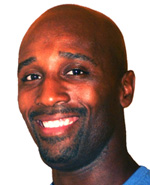 ANTHONY L. WILKINS
ANTHONY L. WILKINS
Blog: March 2014
“Common Golf Injuries”
For the lucky few golfers across the country you have been able to play the game year round. But for the rest of us, we are still trying to dig out from the inches of snow & ice that Mother Nature has blessed us with. Once we finally thaw out I am sure we will all be back on the course as soon as possible. While getting back to playing the game that we love we will at some point be reminded of one or more of the game’s common injuries. Here are a few reasons why average golfers become injured in the first place:
- Average golfers have no pre-round or pre-practice warm-up or stretching routine
- Average golfers have various pre-existing postural limitations due to sedentary lifestyles or work conditions
- Average golfers may have poor swing mechanics based around body limitations which are not addressed through professional instruction
- Average golfers generally do no other physical exercise outside of playing golf
Golfers can get injured in many ways but here is a list of the most commonly seen golfing injuries:
Elbow
Golfer’s elbow injuries are a common problem and are similar to tennis elbow, because it is the inflammation of the elbow joint, muscles and tendons close to the elbow. Golfer’s elbow or medial epicondylitis is usually felt on the inside of the elbow and the problem develops because of overuse of this part of the body.
The average golfer generally swings a golf club anywhere from 80 to 100 times during a round of golf. This count does not take into account the several times you swing a club during warm up as well. The repetition can also stress the elbow and gripping a golf club the wrong way can also damage the elbow when it is swung. The elbow can become painful and stiff, with making a fist an especially painful act. The hands of a golfer may also begin to feel weak in a player experiencing golfer’s elbow.
Shoulder
By far the most common golf injury that affects the shoulder is a rotator cuff injury. The wear that a golfer’s swing puts on the set of muscles associated with the shoulder and its socket can tear them as well as tendons, precipitating scar tissue which can impair movement. Arthritis, bursitis and other inflammatory conditions can occur in the joint. In rare instances a golfer can even dislocate his shoulder.
Back
Probably the most common health problems faced by golfers are back problems. Almost 36% of the injuries golfers reported were back injuries. There are two factors that make the back the most commonly injured area of a golfer’s body. The first is the motion of his or her golf swing while the other is the fact that golfers employ putting stances in which they are often hunched over. Both of these actions put undue strain on any golfer’s entire spine.
More specifically, stress from the repetition of a golf swing can also impact the lumbar spine. Weekend warrior golfers are even more susceptible as they are more likely to use more swings in any given round. The mindless bending over used to retrieve the golf ball, pick up clubs or golf bags, and replace divots also contributes to back injuries. Lastly, back arthritis is common in those that golf frequently as it can plague the worn out vertebrate and result in chronic pain.
Wrist/Hand
The wrist action that a golfer uses, as well as the impact of hitting the ball with a golf club, places a lot of stress and pressure on the wrist and hands. When golfers hit the ball, the impact travels through the club and is absorbed by the hands and wrists. As the strokes mount up, they can lead to hand and wrist injury. Tendons can be strained and eventually lose their mobility.
Tendinitis, a stiffness and swelling of a joint, can occur as can carpal tunnel syndrome, a numb feeling that radiates from the wrist to the fingers. Pain in a golfer’s hands can be brought about by hard to detect fractures of certain bones that result from striking the ball over and over.
Knees
A golfer’s swing can contribute to or worsen a knee injury. Symptoms such as the knee clicking when the golfer walks, pain located in the knee, and swelling that gets worse when the knee is used are common.
Hips can also sometimes be injured by golfers, although this is not a frequently seen injury. The continuous internal and external rotation of the hips will place pressure on both hip sockets. However, existing hip problems can be exacerbated by golfing and a golfer may potentially do even more harm as each round of wear adds up.
While playing the game of golf injuries are bound to occur. Whether you are playing in your club championship or simply getting in some range time, being physically prepared will allow you to perform at your best from your very first swing.
Well, until next time,
Anthony
Anthony L. Wilkins is a national Academy of Sports Medicine & Titleist Performance Institute Certified Personal Trainer an avid golfer from New Jersey who currently resides in the metro Atlanta area with his wife and son.
 Send Anthony an Email Message!
Send Anthony an Email Message!
AnthonyLWilkins@gmail.com



